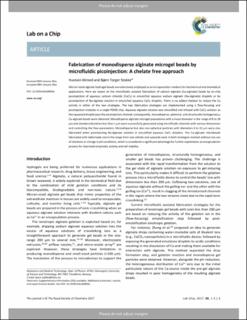Fabrication of monodisperse alginate microgel beads by microfluidic picoinjection: a chelate free approach
Peer reviewed, Journal article
Accepted version

Åpne
Permanent lenke
https://hdl.handle.net/11250/2984192Utgivelsesdato
2021Metadata
Vis full innførselSamlinger
- Institutt for fysikk [2686]
- Publikasjoner fra CRIStin - NTNU [38047]
Sammendrag
Micron-sized alginate hydrogel beads are extensively employed as an encapsulation medium for biochemical and biomedical applications. Here we report on the microfluidic assisted fabrication of calcium alginate (Ca-alginate) beads by on-chip picoinjection of aqueous calcium chloride (CaCl2) in emulsified aqueous sodium alginate (Na-alginate) droplets or by picoinjection of Na-alginate solution in emulsified aqueous CaCl2 droplets. There is no added chelator to reduce the Ca activity in either of the two strategies. The two fabrication strategies are implemented using a flow-focusing and picoinjection modules in a single PDMS chip. Aqueous alginate solution was emulsified and infused with CaCl2 solution as the squeezed droplet pass the picoinjection channel; consequently, monodisperse, spherical, and structurally homogeneous Ca-alginate beads were obtained. Monodisperse alginate microgel populations with a mean diameter in the range of 8 to 28 μm and standard deviation less than 1 μm were successfully generated using microfluidic channels with various dimensions and controlling the flow parameters. Monodisperse but also non-spherical particles with diameters 6 to 15 μm were also fabricated when picoinjecting Na-alginate solution in emulsified aqueous CaCl2 droplets. The Ca-alginate microbeads fabricated with tailormade size in the range from sub-cellular and upwards were in both strategies realized without any use of chelators or change in pH conditions, which is considered a significant advantage for further exploitation as encapsulation process for improved enzymatic activity and cell viability.